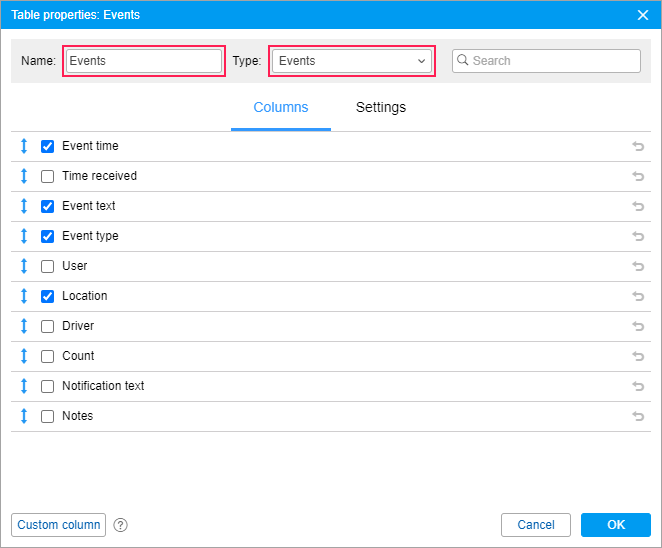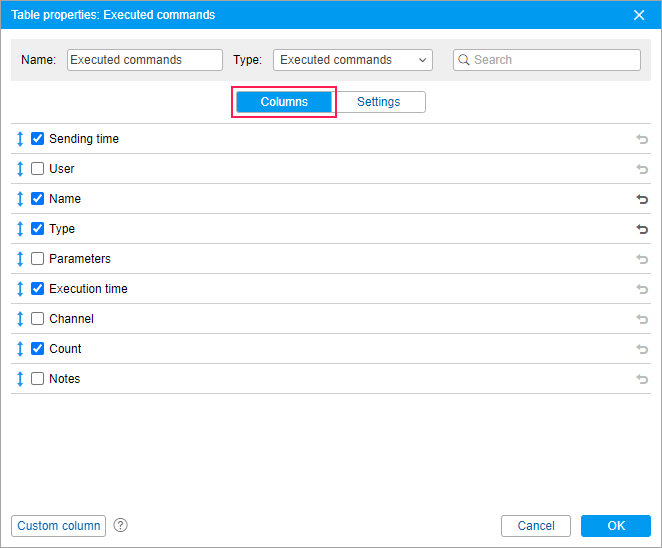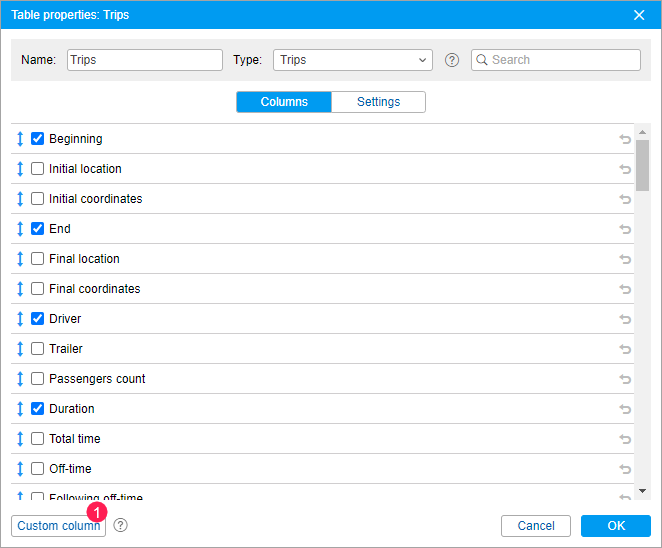Tables
You can add any number of tables to a report template, including tables of the same type. To add a new table, open the Contents tab in the properties of the required report template and click on the New table button.
In the table properties, specify its name and type and select the columns you want to include in it. If necessary, add custom columns and configure additional settings.

Selecting columns
The set of available columns depends on the selected table type. To add a column to the table, check the box to the left of its name. To add all columns at once, hold down Ctrl and mark any column which is not selected. You can cancel the selection of all columns in the same way. To quickly search for columns, use the dynamic filter in the upper-right corner.

To edit the name of a column, click on it with the left mouse button. To use the default name of the column, click on the icon  in its line. The icon is inactive is the default name is used.
in its line. The icon is inactive is the default name is used.
If necessary, you can change the sequence of columns in the table. To do this, click on the icon  to the left of a column and drag it to the required place while holding down the left mouse button.
to the left of a column and drag it to the required place while holding down the left mouse button.
Some alternative types of reports are available as apps:
- iDriveSafe — evaluation of the quality of driving;
- Dashboard — presentation of key indicators of fleet efficiency in a graphical form.
Adding custom columns
The calculator is available in all the tables except for Images, Video, and Statistics. It allows you to add custom columns. To the left of the column names, you can see their indexes (C0, C1, C2 … CN). The indexes do not change regardless of the column position in the list.
To add a custom column to the table, follow the steps below.
1. Click on the Custom column button.

2. Specify the formula for calculating the value in the column.

In the formula, you can use:
- indexes of other columns (indicate them manually or click on the necessary ones in the list);
- unit parameters:
rcoef: consumption by rates,
dehr: daily engine hours rate,
mcoef: mileage coefficient,
imei: unique ID; - profile properties of the unit formatted as profile_field(key), including the unit type, the vehicle type and subtype;
- data on the report interval:
interval_days: interval duration in days,
interval_hours: interval duration in hours,
interval_beginning: interval beginning,
interval_end: interval end; - custom fields formatted as custom_field(name);
- constant values formatted as constX;
- signs +, -, *, /, () for mathematical operations.
Thus, a formula can look, for example, as follows: (С1+С2+С7)*const1.5/rcoef.
You can select the unit parameters and profile properties in the menu that opens when pointing to the ‘(…)’ in the Formula field.
You cannot use the unique ID and profile properties in the formula together with other components. Otherwise, a dash is displayed in the custom column in the report.
To display a custom field value in a custom column, type custom_field(field name) in the Formula field. Instead of the name, you can use its mask. If the names of several custom fields correspond to the indicated mask, the report shows the value of the field that comes first in the list of custom fields in the properties of the object.
If the custom field value is indicated in numbers (without the unit of measurement), you can use it in the formula together with other components. With another type of custom field values, a dash is displayed in the custom column in the report.
3. Specify the name of the custom column.
4. Indicate the unit of measurement (up to 10 characters).
5. If you use the custom column to calculate duration, select how it should be displayed in the Conversion drop-down list.
- Without conversion. Duration is displayed in seconds.
- Duration format. The Duration format option from the table settings is used. If there is no such option, the result is displayed in the hours:minutes:seconds format.
- Date and time format. The date and time format indicated in the user settings is used.
If the value cannot be converted to the selected format, a dash is displayed in the custom column.
6. Click Save.
The custom column automatically goes to the top of the list. However, you can change its position in the standard way if necessary. Such columns are highlighted in blue and do not have an index.

To edit the created column, click on the icon  , column name, formula, or unit of measurement, make the necessary changes and save them.
, column name, formula, or unit of measurement, make the necessary changes and save them.
The value of the custom column in the Total row is calculated in the same way as for other rows, that is, in accordance with the specified formula that uses the values of the column.
Table settings
For each table, in addition to selecting columns, there are additional settings, located in the same-name tab.

The tab is divided into three sections: